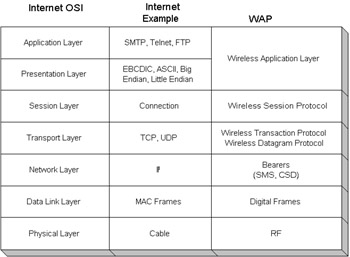WLS
TLS has Wireless TLS for wireless support and is supported by the WAP Forum. Wireless devices are slowly becoming predominant for receiving and transmitting information without the use of a laptop or desktop, and handheld devices are used to transfer stocks and receive e- mails , all of which requires security. Security is also needed for the information to and from Web servers. Wireless Transaction Protocol was invented to transfer secure messaging at the Transport Layer. However, there are many differences in the protocol stack. WAPThere is complexity involved in the Physical Layer of the Wireless Application Protocol (WAP). An example is WAP that supports UDP instead of TCP. Compression is applied to many of the packets, and a WAP gateway is used to translate application protocols from one medium to the next . WAP is used to transmit the information over a low-bandwidth wireless environment, and unlike a LAN wire, various frequencies and hops are applied through the transmission of radio frequencies (RFs). Many electronics are used to minimize the noise across the line, and in Personal Communication Systems (PCS) the signal is distributed within the noise to hide the digital signals. The digital encoding is exposed by different digital shifting techniques and centering on the frequency that is specific for the bandwidth. Echoes of this center frequency can also introduce harmonics. Changing the physical mediumBefore PCS, scanners could easily pick up wireless phone conversations. Going through the Protocol Gateway does change the physical medium, but other translations are needed through the protocol layers to ease the protocol-to-protocol match. The HTTP and FTP protocols must communicate from the IP to the WAP world exactly so that the Internet protocols may be used from one medium to the next with only minor changes. Some of these changes are text sizes, the number of lines displayed, and amount of graphics transported. In this model the transmission is done in the RF up to the Bearers. The Bearers are the different underlying protocols that a mobile device can use to communicate with the wireless network. The Bearer bares the frames on top of the RF and translates them into the UDP packets. As mentioned previously, datagrams are a connectionless protocol; this means that there is no guarantee that the message will reach the receiver. Some protocols, such as SMTP, are also connectionless. When an e-mail is sent, there is no guarantee that the receiver will receive it. However, acknowledgements can be built on top of the datagrams. This is accomplished with the Wireless Transaction Protocol (WTP) that provides the reliability of the messages. This will establish packets that are connection-oriented or like TCP. Figure 22-6 shows the WAP protocol stack.  Figure 22-6: WAP protocol stack WSPThe Bearer Services normally support protocols like Short Message Service (SMS) or Circuit Switched Data (CSD). SMS sends lots of short messages to the mobile device. CSD is like a modem being connected to a laptop that interacts directly with an Internet service provider (ISP). The Wireless Session Protocol (WSP) handles session management just like in sockets. The difference is the commands such as an S-Connect; the client and server scenario is still used as in the Internet Protocol stack. WTLSThe Wireless Transport Layer Security (WTLS) goals are to provide privacy, server authentication, client authentication, and data integrity. For WTLS to be supported, TLS must also be in place at both the client and the server. This security is needed in order to connect to secure systems such as online banking. The client and server are both authenticated, the message is encrypted, and the message is signed using a one-way hash to ensure that the message has not been intercepted and tampered with (as in the man-in-the-middle attacks).
Java Security Solutions ISBN: 0764549286
EAN: 2147483647 Year: 2001
Pages: 222 Authors: Rich Helton, Johennie Helton
flylib.com © 2008-2017. If you may any questions please contact us: flylib@qtcs.net |